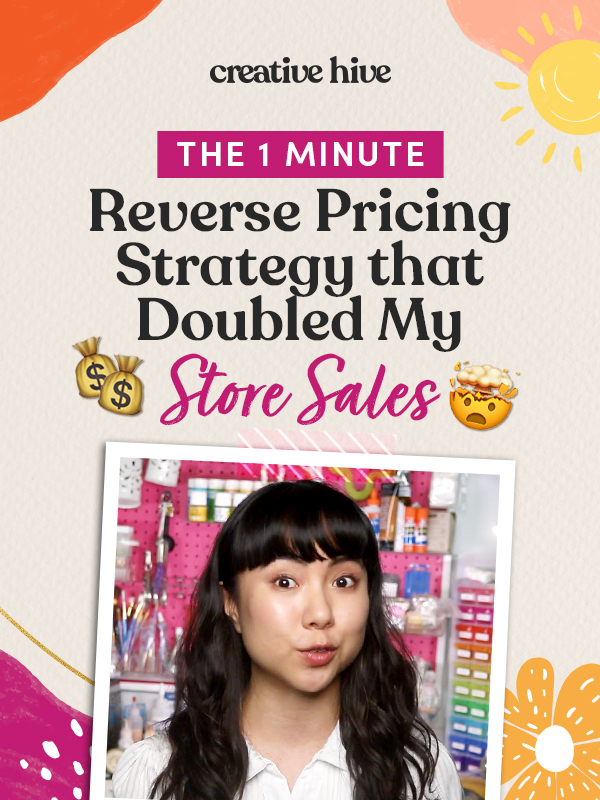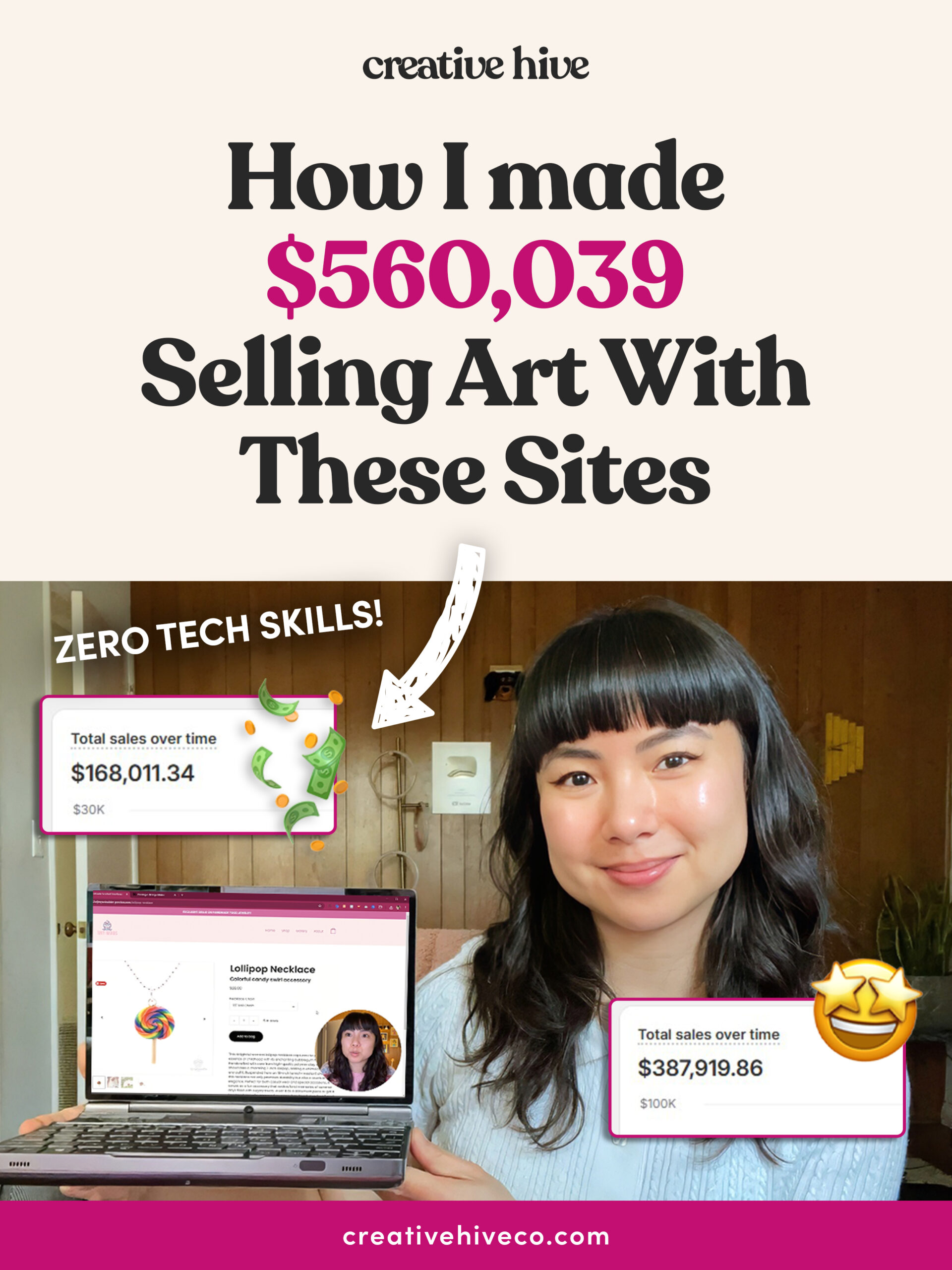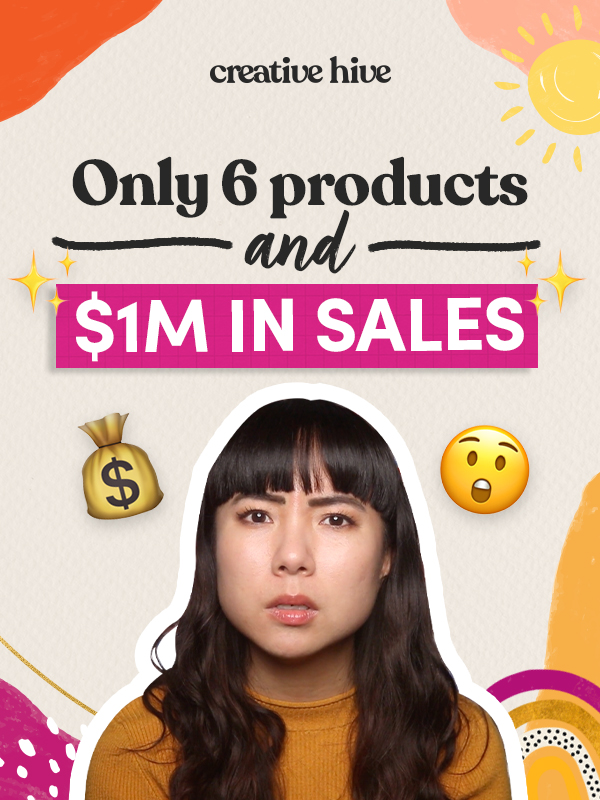I want to help you build a sustainable, profitable handmade business that makes you consistent income and sales. I only ever teach or recommend marketing, social media, pricing, production and branding tips that I’ve personally used successfully in my own 7-figure handmade businesses.
I'm Mei, from Los Angeles!
Read More
Popular Posts You'll Love
Looking for something?
Categories
starting a business
get more traffic
running a business
make more sales
branding
growing a business
mindset & productivity
podcasts
pricing & money
product photography
reviews
selling on etsy
selling on amazon
social media
selling wholesale
- Facebook0
- Twitter1
- Pinterest0
- 1share
I used a unique “Reverse Pricing” strategy in my handmade jewelry store, and it completely transformed my sales – doubling them in just a short period of time.
The most amazing part about this is that it only takes me a minute to do each time.
This strategy isn’t limited to just jewelry, but it works for selling any type of physical product. Even services or digital products!
Now, here’s the kicker: Reverse Pricing is a counterintuitive approach.
It flips the conventional pricing methods on their head, and that’s exactly why it’s so powerful.
In fact, very few people do this.
However, if you get it right, it can work so well at making you more money with your business without overcomplicating things.
The beauty of this strategy lies in its simplicity and flexibility, making it perfect for handmade businesses of any size.
The Price War
Before we dive into Reverse Pricing, we need to get you on the same page first or all of this won’t make any sense.
Most store owners, when they see that their products aren’t selling, default to lowering their prices to attract more people to buy, thinking that’s the only way to compete.

If you’ve ever sold on Etsy or any similar platform, you’ll know exactly what I mean.
You see your competitors—often selling products that are very similar to yours—start to drop their prices.
And naturally, you feel that pressure too.
You think, “If I don’t lower my prices, I’m going to lose sales.”
Then it’s a race to the bottom as you compete on pricing.
It becomes less about quality, uniqueness, or even brand loyalty, and more about who can offer the cheapest deal.
And that might seem logical – after all, we’re led to believe that customers are always price-comparing when they shop.
But, the thing is, not everyone is comparing prices.
In fact, many customers are basing their decisions on entirely different factors – things like the perceived value, the quality, or even the emotional connection they feel with your product or brand.
So when you get stuck in that price war, you’re not only undervaluing your product, but you’re also ignoring a whole segment of your audience who’s willing to pay for something more than just the cheapest option.
Price comparison shopping is most common when customers perceive a product as a commodity—meaning, it’s viewed as essentially the same as other similar products.
For example, if Shop A is selling an amethyst necklace and Shop B is selling one that looks almost identical, shoppers are likely to choose the cheaper option.
This puts you in a tough spot.
When your products are seen as commodities, it becomes much harder to differentiate yourself, and you start feeling the pressure of competition even more.
Being stuck in this position means you can’t charge what you truly deserve for your work, and scaling your shop becomes an uphill battle.
It’s frustrating to feel like your hard work is undervalued because, on the surface, it seems like your products are “just like everyone else’s.”
But if you’re thinking, “I don’t want to sell a commodity product!”—I’ve got good news for you. There’s a simple solution.
I offer a free workshop that teaches you how to make small but effective tweaks to your products so they can stand out in a crowded market.
It’s actually really simple to not be a commodity if you know what small tweaks you can make to your products to make them truly unique and irresistible.
It’s important to understand that we all value things differently.
What might seem like a reasonable price to one person could feel like a bargain – or too expensive – to someone else.
As artists and makers, we often become hyper-aware of pricing, because we understand every aspect of what goes into making our products.
We know the cost of materials, the time, effort, and creativity involved in the process.
And because we’re so close to our work, we often undervalued it, pricing it too low, especially when we factor in our own time and energy.
But here’s something to keep in mind: most of your customers aren’t other artists or makers.
They don’t know the ins and outs of how your product was made.
They’re not thinking about the price of each bead, or how long it took to shape that piece of metal.
Instead, they rely on the cues your shop is giving them to assess whether your product is worth the price you’ve set.
That means everything from your photos, descriptions, and branding to how you present yourself as a business plays a role in shaping their perception of value.
So while you might be inclined to keep prices low because you’re conscious of the production process, remember that customers don’t have that same insight.
They’re simply looking for signals that your product is worth every penny.
I’m sure you’ve experienced this before: you come across an incredible product that looks well-made, high-quality, and has a stunning design.
But then you notice the price is surprisingly low… almost too low.
And what’s the first thing that crosses your mind? “Something’s off.”
You start to wonder if there’s a hidden flaw or a compromise in quality.
A more informed buyer might recognize that the product is inexpensive because it was produced in a developing country, or perhaps instead of high-end materials like cotton, they used polyester to cut costs.
But this is insight that typically only someone familiar with production and materials would have.
The average customer doesn’t always know the differences in material quality or production costs.
I’m a maker myself, right?
I work mainly with polymer clay, so I’m more familiar with that space.
But when it comes to fiber arts, I don’t have the same knowledge.
It wasn’t until just last year that I learned cotton is generally more expensive, more desirable, and more comfortable than polyester.
My point is, if even as a maker I didn’t fully understand those distinctions, imagine how much more in the dark the average customer might be.
They often rely on price as a signal of quality because they lack the deeper knowledge of materials or production processes.
The key takeaway here is that not all customers are driven solely by price.
Price is just one component of a person’s overall value system.
When someone says, “I’m getting a good value,” it doesn’t always mean they found the cheapest option.
In fact, they might have paid more, but it feels like a great value because of everything they gained from the purchase – the full package.
For some customers, quality and durability are what matter most.
Others place a higher importance on eco-friendly production methods and materials, while some may not care about that at all.
My customers, for example, are particularly drawn to products that are unique and novel.
They’re willing to pay more for an experience that feels fresh, new, and different… something my shop can deliver.
The bottom line is, most people are primarily concerned with the outcome of what we make.
They care about how it fits into their lives and what it offers them.
But as makers, we often spend too much time focused on the process—how the product is made, the materials we use, and the effort involved.
What we, as shop owners, value is often very different from what our customers value.
This is where many of us get stuck, because we assume customers are prioritizing the same things we do when, in reality, they’re looking at a much bigger picture.

The 1-Minute Reverse Pricing Strategy
So, what exactly is this 1-minute “Reverse Pricing” strategy that doubled my store sales?
Now that you understand how most shops default to lowering prices when sales slow down, let me tell you about something completely opposite: the “Reverse Pricing” strategy.
Here’s how I used it: I decided to do a price experiment on my best selling item, the Scented Snow Cone Necklace.
At the time, I was selling it for $28, and sales were great.
I was actually selling so many that it became difficult to keep up with demand.
Each necklace took a fair amount of time to make, so I realized I had room to raise the price and potentially make more profit.
I started by increasing the price to $35 to see what would happen.
Surprisingly, the price jump didn’t affect sales at all.
If anything, more people started buying at the higher price.
Encouraged by this result, I decided to test $35 versus $40.
Once again, the higher price outperformed the lower one, with even more sales at $40.
I then took it a step further and tested $40 versus $45, and, as you might guess, the $45 price point sold more units and brought in more profit overall.
Now this is where things get interesting.
I decided to keep pushing my price experiment to see just how far I could go.
Naturally, the next step was to test $45 versus $50, right?
But this is where I hit a turning point.
At the $50 price point, I finally saw a drop in sales.
It became clear that I had reached the limit.
$45 seemed to be the sweet spot where sales were highest.
So, I figured that was it.
I had found my ideal price, and I could stop experimenting.
But then, a few weeks later, something clicked.
Out of nowhere, an idea popped into my head, and I realized there was one more test I hadn’t tried.
Can you guess what it was?
I decided to test between $45 and $49.99, which, in my mind, is essentially the same as $50.
But here’s the fascinating part: the $49.99 price won!
At this price, which is almost double what I originally charged for the necklace, I noticed some positive changes: more people were viewing the product listing, more were adding it to their cart, more were checking out, and, ultimately, I was making more sales, revenue, and profit.
The best part?
I didn’t have to change anything else about the product.
The product itself, the packaging, the description—everything stayed exactly the same.
Isn’t that so fascinating?
A simple price adjustment transformed the entire dynamic of my sales without any extra effort on my part.
Can you imagine if you could apply this to your own shop?
You’d only need half the traffic to make the same amount of money.
That means less time spent on marketing and more time doing what you actually enjoy.
You’d be working smarter, not harder in making more money with the same amount of effort.
This, to me, is the definition of leveraged income, which means earning more without needing to pour in more time or resources.
It’s an incredible way to grow your business without burning out, and it’s exactly what I aspire to create more of in my own shop.
Just by tweaking your pricing, you could achieve that balance of working efficiently while maximizing your profits.
This experiment is also a perfect example of how charging too low might actually be hurting your business.
When I was selling this very detailed, unique necklace for $28, I was making fewer sales.
Lowering the price meant that fewer people had the chance to enjoy my products, which is a real shame.
My products are special, detailed, and they make people smile.
They’re fantastic gifts and bring a bit of magic into people’s lives.
If I charged less, I was undervaluing the necklace and limiting the joy and happiness it could spread.
And there would be less of all that magic.
It’s fascinating to see how important it is to align your product’s perceived value with its pricing.
Take my snow cone necklace, for example.
To many people, it appears detailed, appealing, and fun. Plus, it’s scented and completely unique – features that significantly boost its perceived value.
Now, let’s consider an extreme example to prove my point.
Imagine I priced the necklace at $10, an unusually low price for something so distinctive.
Your brain might immediately start sending off alarm bells, thinking, “This must be too good to be true,” or even “Is this a scam?”
When the pricing is so out of sync with the high perceived value of the product, it can lead customers to question its legitimacy.
They might wonder if they’ll actually receive the item or if the shop is just out to take their money.
If you’re making your customer think thoughts like that, they’re for sure not going to buy from you.
Now, before you rush off to your store and start haphazardly increasing your prices, let’s be clear: the reverse is also true.
If you have a product that appears poorly made or if your product photos aren’t great, slapping a high price tag on it can backfire.
People will likely think it’s overpriced and might not buy it at all.
Similarly, even if your product is exceptionally well-made and stunning, if your website is poorly designed, your logo looks unprofessional, or if your site triggers antivirus warnings – things like that are going to lower the perceived value of the product, then a high price will not feel justified.
No matter how amazing your product actually is.
In essence, everything about your brand and presentation needs to work together.
If there’s a disconnect between your product’s quality and the overall presentation of your brand, it can undermine the value you’re trying to communicate.
Make sure that your pricing is supported by a professional and trustworthy presentation to truly justify and reflect the value of your products.
If your shop has good branding, good products, photos and so on, then definitely consider charging more.
This adjustment can be made in 60 seconds or less—simply log into your website, update the price, and press save.
It’s literally the easiest thing you could do today to make more money without any extra work.
But then again, if you’re feeling like your branding isn’t very good, and you’re not super confident about your products, photos, and website, sign up for my free workshop that will help with all of that.
I will help you enhance all of these elements so you can confidently set higher prices and truly reflect the value of your products.
If you’re concerned that a price increase might upset your customers, you don’t have to make a drastic jump all at once.
Instead, consider gradually increasing the price by a few dollars every few weeks or months.
Most customers won’t be closely tracking every price change in your shop and likely won’t notice small, incremental adjustments.
Besides, the customers you truly want to work with will understand the need for raising prices.
If they don’t, do you really want to be working with them anyway?
Focus on attracting customers who appreciate the value you offer and are willing to invest in it.
The Nerdy Creatives Club
If you’re interested in more strategies like this—small tweaks that can boost your sales—or if you’re curious about how to conduct pricing experiments in your shop, you’ll definitely want to join the waitlist for the Nerdy Creatives Club.
This is my new space where I dive into fun experiments and provide actionable tests that you can implement in your own shop each month to increase sales, enhance profits, and reduce the time you spend on your business.
All so you can put all that extra time towards the things you really love.
The Nerdy Creatives Club is all about working smarter, not harder.
It’s a big mission where I want to bring together ambitious creatives who are ready to break away from hustle culture.
I only open doors to join the Club a few times a year and accept a limited number of members each time.
If this sounds like something you’d be excited about, make sure to join the waitlist here!

Leave a Comment
Liked this article? Share it!
Unlock a Profitable Handmade Business
in Just 12 Weeks Without Using Etsy
or Social Media
FREE WORKSHOP
This workshop is for anyone who makes and sells a handmade or physical product, including jewelry designers, artists, paper designers, bath & body product makers and more!
What You'll Discover
The #1 mistake people make with Etsy & social media that causes shops to FLOP
The secret to making it with your handmade shop so it's no longer just a hobby
How to make sales in your handmade shop with ease so you can finally get to 6-figures
TAKE ME THERE
Your email address will not be published. Required fields are marked *
Leave a Reply Cancel reply
About
Blog
A Sale A Day
Student Login
Free Class
Contact
Terms
Become A Student
Watch On YouTube
Student Reviews
See My Handmade Shop!


Using services like https://writepaper.com/history-paper can be a helpful resource for students who need assistance with writing assignments. These platforms often provide guidance on structuring papers, conducting research, and improving overall writing skills. However, it is important to use such services ethically. Students should avoid submitting work that is not their own, as this can hinder their learning and academic integrity. Instead, these services should be viewed as a tool for support and inspiration in the writing process.
For many people, online casinos are also a way to socialize. A huge number of players around the world are gathered on one platform, and https://plinko77.com/ can interact through chats, discussing strategies, sharing game experiences or even making new acquaintances. In a game of poker or blackjack, where not only luck is important, but also strategy, interaction with other players becomes part of the fun.
Reverse pricing sounds like a game-changer.
Reading your content was enjoyable. I’m forward to see your post when it becomes live. Have success with your next update. This essay is very interesting and helpful.